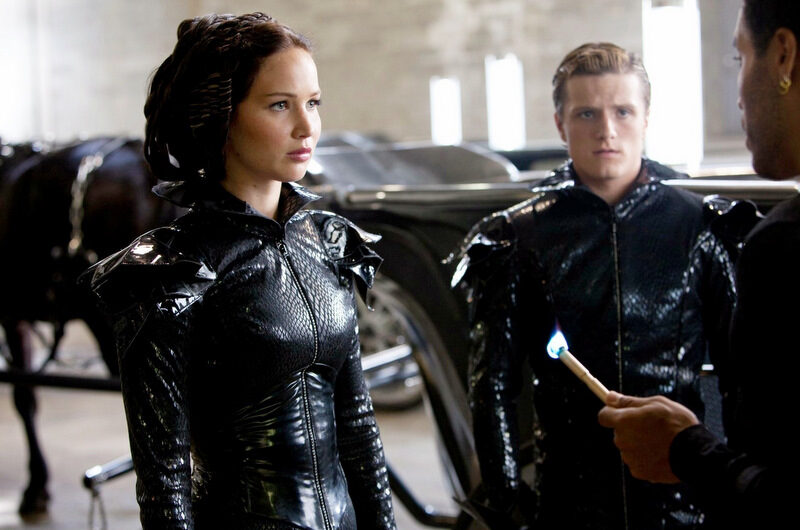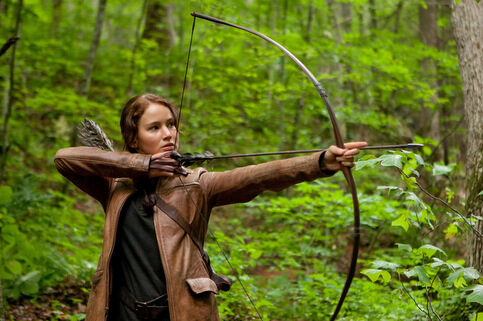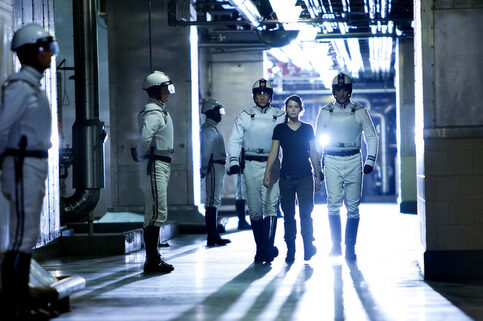Review: The Hunger Games |
 © 2012, Lionsgate 25 Mar ’12
© 2012, Lionsgate 25 Mar ’12
Starring: Jennifer Lawrence, Josh Hutcherson, Liam Hemsworth
Directed By: Gary Ross
Set to ignite many a misconceived fashion editorial, The Hunger Games succeeds as pure costume delight because first and foremost it serves narrative. Judianna Makovsky has brought to life a new world, not created a magazine spread.
The film is based on a trilogy of novels by Suzanne Collins and centres around Katniss Everdeen (Jennifer Lawrence), who volunteers to take her sister’s place for the annual Hunger Games, a fight to the death contest in the wilderness between 24 ‘tributes’ aged 12-18 with only one winner gaining his/her freedom. Taking place in post-Apocalyptic North America presided over by a privileged few in Capitol, which resembles Logan’s Run crossed with the Star Wars prequels, tributes are selected from districts that many years ago instigated a failed revolution against their oppressors. The Hunger Games are Capitol’s way of reminding these districts of their place, plus some meagre hope for the future.

Costume designer Judianna Makovsky was careful to replicate clothing as described in Suzanne Collins books. However, compromises had to be made as not everything would translate well on screen. Katniss Everdeen’s (Jennifer Lawrence) leather coat worn when hunting, for example. In the text it is described as ‘oversized’, a hand-me-down from Katniss’ father, but in the film it is sleeker and more deliberately tailored.
Although the books already have a built-in fan base among young adults, this is a movie first, adaptation second. Story is everything; The Hunger Games needs to draw a new audience with no prior knowledge of its universe. Fortunately director Gary Ross strolls through the plot in no big hurry spelling out all we need while inspiring questions that will hopefully be answered in sequels. Ross is aided immeasurably by Judianna Makovsky’s costume design. Clothes are an intentional method of deciphering The Hunger Games’ politics.
Having the divide between right and left, rich and poor so blatantly defined is a godsend for newbies because Ross does not establish his world upfront but lets it unfold gradually throughout. We are given a hint at just how decadent Capitol has become when Effie (Elizabeth Banks) proudly rounds up combatants for the games standing in what appears to be the outskirts of a disused factory. A frail looking thing wearing fuchsia skirt suit with peplum, Effie transcends mere affluence by adhering to a doctrine of crippling physical misery via fashion. She cannot possibly be comfortable tottering in high heel booties, her ribs crushed by corsetry and face slathered in translucent powder. Of course, this is the point; she is just as much a prisoner as Katniss.

Effie Trinket (Elizabeth Banks), Capitol chaperone for Katniss. Banks’ costumes echo the style of avant-garde Italian fashion designer Elsa Schiaparelli (1890–1973), creator of the celebrated ‘shoe hat’, amongst many other ground breaking and zany ideas.
When the story arrives at Capitol proper we are introduced to conspicuous consumption run amok. The clothes are quite beautiful in isolation and perfectly fitted – several lounge suit variations on Caesar Flickerman (Stanley Tucci) especially – though it is all just too much; too many pockets on jackets, too much pouf on dresses, too much appliqué and far too much colour. Those in Capitol have no limits so wear absolutely everything, seemingly at once. It is all form and no function. Cinna (Lenny Kravitz), Katniss’ stylist for the Games is a notable exception; his clothes are subtle, just black suits and no tie, with gold eyeliner a minor indulgence.
The contrast between Capitol and the districts is silk and cotton. Katniss may hunt deer in long leather boots and a leather coat, but when she joins her sister for the selection lottery, a delicate early 19th century prairie dress is chosen (most likely compulsory). These dresses would be homemade and probably a source of some pride to their owner, though Katniss wears hers with palpable scorn. Capitol prefer inhabitants of the districts to appear wanting and humble. Any semblance of hope must be earned.

The Capitol guards’ uniforms are loosely based on modern day motorcycle police but attired in white rather than black (taken from the books); Judianna Makovsky found inspiration in the simplicity of Tony Walton’s work for Fahrenheit 451 (1996).
Later in the story, Katniss’ clothes alternate between training/outdoor gear and conscious display intended to court Games’ sponsors, her ‘Girl on Fire’ silk taffeta showstopper being as impressive (and oddly plausible) as you might hope. To say Katniss seems just as comfortable in both styles signifies that, for the moment anyway, she is in limbo. Her true calling has not become apparent. Jennifer Lawrence’s performance in The Hunger Games is a highlight. When the pace flags, which occurs on several occasions under weight of exposition, her charisma carries it through. Katniss may not have much of an arc in this particular film but Lawrence has firmly embedded herself within the character. If for some reason she cannot return for the sequels they might as well reboot it.
While ultimately nothing new and weak under cross-examination (why would everyone in Capitol actually enjoy watching children kill each other?), The Hunger Games is still exciting and gently satirical enough to please most audiences, not just teenagers. As with all adaptations of admired books it cannot and will not please everybody. Jennifer Lawrence, however, will.
The Hunger Games was released on 23rd March.
© 2012, Chris Laverty.
